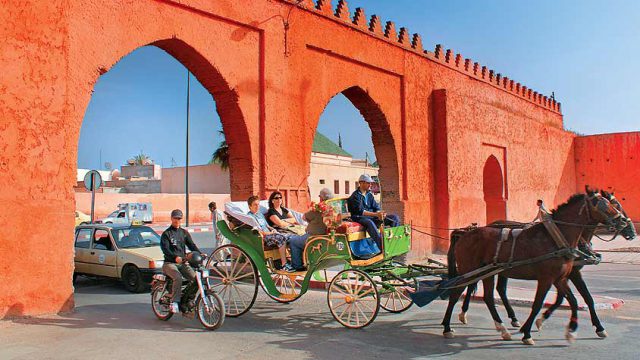Before travelling to the medieval marvel that is Marrakech, I did a fair bit of reading and trawled the internet for all the information I might conceivably need. I watched The Man Who Knew Too Much, the Hitchcock classic that’s set in this Moroccan city, a number of times. But no amount of homework, it seemed, could have prepared me for the sights and sounds of the old fortified town or medina of Marrakech: for its wild labyrinthine streets that just would not let me find my hotel, for the stream of Arabic words in which I thought I would soon drown, or for the delightful chaos all around. There were orange juice vendors hollering, snake charmers playing music, men in full-length jellabas telling stories and fortunes, women in veils scurrying past with children scampering in their wake, mule-drawn carts jostling with Mercedes for road space and overwhelmed tourists capturing the ‘exotic’ with their cameras.
The souks of the medina are the nearest things to the bazaars of Arabian Nights — bustling squares surrounded by a dense maze of narrow alleys selling an endless list of items: dried fruits, spices, pickles, olives, ceramic pots, wooden chests, baskets, perfume, shoes, kaftans, jewellery, and, of course, carpets!
The main attraction of the medina is the centuries-old Jemaa el- Fnaa, the central square. At daytime, you will find the square occupied by snake charmers, fortune-tellers, henna painters, fire jugglers, traditional healers and fruit sellers. As the shadows lengthen, the snake charmers make way for the dancing-boys. Sunset at the square is sublime, and as you gaze in wonderment at the Koutoubia mosque silhouetted against a red sky, the performers slowly move out. And in roll a hundred food stalls. Come evening, the square is transformed into arguably the world’s largest open-air barbeque site. The food stalls serve a mind-boggling variety of dishes: snail soup served in small bowls, lamb chops, fish, kebabs, breads and tagines to go with them. Every dish is served with a small glass of mint tea, Morocco’s national drink.
Marrakech has a celluloid connection too deep to ignore. Lawrence of Arabia, The Man Who Knew Too Much, The Gladiator, The Mummy and many more Hollywood blockbusters have been shot here. However, with the locals, it is Bollywood that rules. In fact, cinema halls showing Indian movies are a common sight.
In complete contrast to the narrow alleys of Marrakech, Casablanca — or Caza, as the locals call it — is a modern city with wide, multi-lane streets lined with palm trees. Its skyline is dominated by the tall minaret (one of the world’s tallest) of the Hassan II Mosque, which stands sentinel-like over the entire city. Inaugurated in 1993, the mosque is Caza’s biggest tourist attraction. And when you enter the mosque, you’re in for an even more breathtaking revelation: a part of it is built right over the Atlantic Ocean, whose waters can be seen below the glass floor of the mosque’s hall! Evidently, King Hassan II wanted the mosque built on the water ‘because God’s throne is on the water.’ He also wanted Casablanca to be ‘endowed with a large, fine building of which it can be proud until the end of time.’
It’s fair to say that that wish of King Hassan II has been realised.




